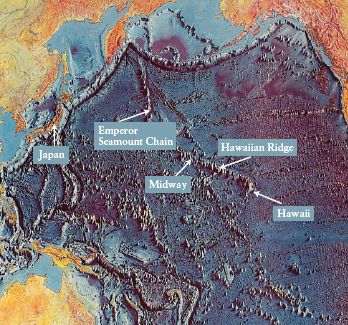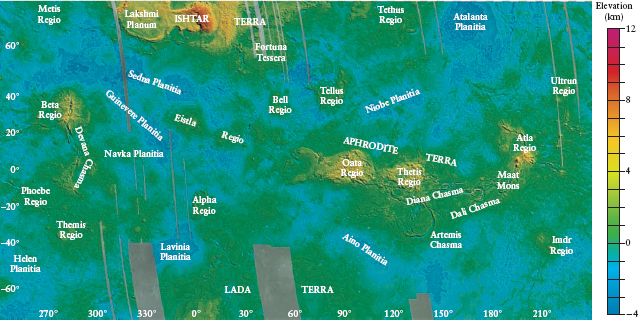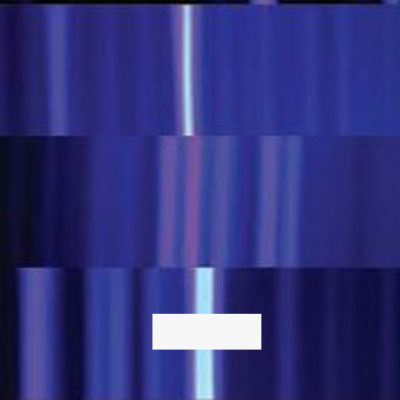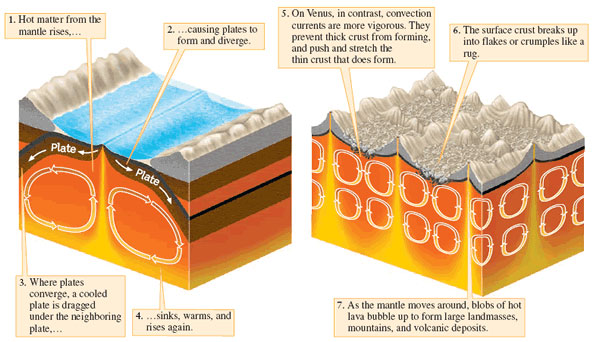Chapter 11. Volcanoes on Venus and Mars
11.1 Introduction

Author: Janelle M. Bailey, University of Nevada, Las Vegas
Editor: Beth Hufnagel, Anne Arundel Community College


The goals of this module: At the end, you should be able to:
- Identify similarities and differences between the volcanic features of Earth, Venus, and Mars.
- Explain how these differences probably came about.
In this module you will explore:
- Topographical maps showing the tectonic surface features of Earth, Venus and Mars.
- Models of how the interior of a planet affects these surface features.
Why you are doing it: Comparison of other planets' volcanic features with those on Earth will help us understand not only how their surfaces differ, but also how the interiors of other planets are different from Earth's interior.
11.2 Background

Venus and Mars are our nearest planetary neighbors. Venus is sometimes called Earth's 'sister' planet, because of its similar size. Mars is the subject of intense robotic (and, in the future, manned) exploration. Like Earth, these two planets are small (compared to Jupiter!) and rocky. They all also orbit close to the Sun, but with Venus closer than Earth and Mars further away from Earth.
Earth has an active tectonic plate system, marked by volcanic mountain ranges where plates are colliding, such as the Cascades on the West Coast of North America, and the Himalayas of Asia. The Mid-Atlantic Ridge, stretching from Iceland to Antarctica, is a chain of underwater volcanoes resulting from oceanic plates spreading apart. When plates spread apart, rift valleys form, though volcanoes don't form there.

Volcanoes are also seen in the middle of plates. Molten rock, magma, wells upward from a stationary hot spot in a planet's mantle and flows out to build a flattened volcano with sloping sides. This is called a shield volcano. As the plates move over the hot spot, a long chain of volcanoes is produced. The Emperor Seamount Chain, formed about 70 million years ago, is so eroded that none of it can be seen from the surface of the ocean.
Volcanoes are important, since they are clues to the nature of a planet's crust and mantle. Since volcanic activity changes the surface features over time, it also helps us determine the history of a planet. In this activity, you will examine volcanoes on Venus and Mars and how these features came about.

11.3 A Look at the Surface of Venus
This topographic map, taken by the Magellan spacecraft's radar altimeter, shows details of the surface of Venus.

Notice that the color shows elevations both above and below the planet's average surface height. The majority of the surface is blue-green, indicating that it has very little variation in its elevation. In fact, most of the surface is within 5 kilometers (km) of the average planetary radius, the distance from the center of the planet. Venus is too hot to have liquid water, so the blue does not mean seas or oceans! (Magellan did not map the gray areas - we have no information about the elevations in those regions.)
Question Sequence
Question 11.1
pRJFicUO72i9BWjMeavsNejGbjYOPfzX/mwfFbNBAxiRpOckX2PxKAiCDeKSz/Or+lKZOSAFpdUqF3aFWvTrq/yKWU34IMyM8rPhntS5GJ74BQPNbTHJ2663wiZ0UpEgHGmyX9zTbS0I5oKgdoH93qx2K8jEj7iYj5uj3UznPcqb2lyiGveybFSJwjuuKhH/TMyk3JYMIQrnl5QwScTYqRsOa0q92pzCOSzAwx1EP+wV6I3jhD2q1bw3cu5JBRAeLEnlLLLhKxbvlDLjxbYbEeyOgh8a5l0SfiP+LcIBNi1TDfUZBADWAYdWWhwo5bbvFgKnG7buYNrLNnwMYJtp60iI/NYEd0HxnI1T55jNMUAD9y4pypkQy4KeZJXchzf8t9J4UWXUJ/5IG/103NrdrqQtVqDvuuzdrNpo1vgSFeGzA5JgD9bLIZ2GMud7UKmo8T/rZ8Lq1Bv44zZ/jV5U8hIiG8gEnyulC5OuGhVUXWIXpZxGg+1fUGPqXrPLAgUWf3aLpXCQ0qzqfmXcv3/rUxPuoSmrvMBhgDSRD1YBzoVyxXwFPzBfyTOPsSNBuT+jn55ic5QhWlE4Q/CoUztpnCSP3yYP5cIU/YYyKwwKXqwXZfNtw/yG+wZmapmRHj+qwZ6AjkoOHWbTz+9o4qvHmHib2HA7GLflfTERX6CIjzVvgPZqr/g1OFGW466FMzmLQt0ywhK+jDPrGVtUawt3wmE9qGzsIqUmSleJsA==Question 11.2
F4cjiBquoGDi20Rr0DnxkW2y9aQdq2tA0Fr8m8Bap5rvy1TSHTBPjFxoWDcpByCOsjdG/oEklbtJWR21cKHKl6c8TEaTzFGxgeerHJqiyp8DyoyHpWefQepq+fVabzdD/X+tBlVBVhFcGVc+GedYzgfFkqAI6b9M4RAYIw5xLSABph895Ayrjur8IomMueQK7+FPc26VNDBv1G1oc3kSoXK61MXbWi8k16ZoeXsKlLGwwdJNZ4a0M9IFhtj6Apqs23om5RDZfCU2A6wjFQ1B/mTB915elW1rTyJqc7LnGANVSaXbCS4FDPEsqxJCw9fGKF8X+JmqX3V6O7b75epi/e6kjKBH6dP89uKnlZ1dXOrrGDX/TSXvr1Nlpcj2dbsNIq1Mhe3I1w14/sm53Rl1E5jxoyNGBY5piXEt5D+GoTL+hfwy04Z1AoljJNcMqdbYmyxA0GPJcEyGeegTBx5Wt77Iu+RaU1qTGID2pDVw+4bHOImb7HrefZ8nYmxqAzS9wGTfYpJ5XSEC1a7PgcjLbi1h/m/fK+pEnk5eVcnk6/87mPjIRxdRLvZVrZ43wmB5Kg6xQEymgwBOaaJcu/UOzA2DEddQor/xzoWP+ebbKiY8iw27MJUCywfhrVfkIf0MDO1K3FNhHeBqAhIyiIf2VWZIFiWvX6LDrmJJUn3X9d1PjInY8asZbe6R06y6IGXmwgckKS0TNX7gQMxJoFb/tviOU/gbycSRup+XhjCpxMkk8j0or/zbSJz7e/4NOn1j+TdwVSwyGat1wNrAeuWR2ixh/ZXpAbBpEcND3QNIb/UaqYHVv5R+8FBBdnsLIutxfuTiLFyIqxGvS8UgyWqPZXcGattEkQ5v11.4 A Look at the Surface of Mars
When you look over the entire surface, Venus is, overall, quite smooth. Not so the surface of Mars! Topographic maps of Mars, like this animation made from data from the Mars Global Surveyor spacecraft's laser altimeter, show that a greater amount of the surface varies from the planetary average.
This animation shows the topography of the Martian surface as measured by the Mars Orbiter Laser Altimeter (MOLA), an instrument on board the Mars Global Surveyor spacecraft. The colors indicate elevation: white is highest, followed by red, yellow, green, light blue, and dark blue (lowest). North is at the top.


Although there are more Martian surface features that stand above or below the planetary average, individual elevation differences are smaller than that of Venus. Notice that the highest points on Mars are only about 8 km above the average, as opposed to about 12 km on Venus. There is also a striking rift valley called the Valles Marineris, which runs parallel to the equator, colored in blue.
Rotate the Martian globe until you find the point where the features are colored white.
Question 11.3
uxBxRpRnwTCXLEVJ46vC8Mbh+tBjp4LDZSZvSK6nmjstoMdtsYkDnirU8K9RMZCqzGqk/wEF++8WZsAqAB0Gw2kxagxqPVtbX8Qw8bp/h/R1oNJTo1OaUy+qPfVHz84R04gOezGzdGX2cJaHUtmBSWsiPgVWUbBgeIuKPuJlQPWAv/cm4KFZ7ZgsbXM9VkygD1FKTiB1oLgyIFrCDLoKrhgqHsb/+DAE0sD1a2G5aSBiAaPoGZ9NeP/PbX/kb8+0uvnz3Z9OiVl53uSbyyVwkCwqKJM1aZe8rBzydssUqFL+vAtxhS2HUMapA0bh8KprlSgEjAWQbMdJYQSOHeRUgqIMLyLUC/Vl6fNiXWOnNVXt6O4rF35ln9qVoevKtw22fm+ps1BQTSeAFQFCXcb3LxF+JcJem6kJcSvAFE68agYimOPbhxBrBrDgJLIdRCfA8GC0MsRAuLI=11.5 Under Venus's Crust
Like Earth, Venus has convection currents in its hot, liquid mantle. However, the crust of Venus is thinner than that of Earth and it is not broken into large plates. Rather than having plate tectonics, like Earth, Venus has flake tectonics that influence its surface features.

The strong convection currents on Venus keep the crust from thickening. Instead, the currents cause the thin crust to crumple, creating 'flakes' in some areas. Between the currents, magma rises to the surface and creates mountains and other volcanic deposits.
From the resulting surface features and the low number of uniformly scattered impact craters, we know that Venus's entire surface must be about the same age. By calculating the time needed to create the observed density of craters, the volcanic activity that shaped the surface that we observe now is thought to have occurred about a half billion years ago.
Question 11.4
tyOXGSaOTA0y2GV/t5h/mRnBkGekMIz9Eb/LoQwqQh4bsF85Wi3yFKEPXePDzruwWfVyPbJFJuKs4/0LfwMT3DPVFvZPbCrGO9Ln3jiAqAX1ED9XV/BjYhCHhkEbqPcRIty08afBWWY05AFtTveM0xSTpXOfQD+k/koh0bHU2yYrL3pT1FCkDdRdeoEsAlYpWqqPO0jwjsc/HsknWVUxh0b18/cwil7t4paaE1LNsaCqDz4aMkB6LWjU5f25KwoZ+M9ylQ==11.6 Hot Spots on Venus and Mars
Neither Venus nor Mars show evidence of plate tectonics like those that are observed on Earth. With the animation below, we can see what happens as the result of a hot spot with and without plate tectonics.
The animation will begin playing with plate tectonics. To view the opposite, click the button on the animation that says "Without plate tectonics"

On this animation, select the "with plate tectonics" option and run the animation.
Question Sequence
Question 11.5
VbzPI5oUNuvffs2A7hbFvLLYC5LkkRPM9ZtqtKurvOiq/j/3OODoeP1Ve7it7eYX8FRTQXiPcjkmt0eDK7WDMf2W4zeu2cS+FZjmyaKeF+jq1KNa/qEFEStGH4S0RQ9RbtZ6z4uoewiN4R5zmn+szHc2x0Boi6KtlztLtZdLw+QgRTiwig/KnQ/qIaDTigAm8QO1gVVCYc34OKLce5Ps8swlJdLjtzm8ReWhr8J9iq8FijHSh2s4oEch3KTpHFg144Hmif2CtBwQE7ZqwcM97v+j8vtCMtQXPoPaRDODLKQYTp08MFWh1lEsMTk3nhw2YboHuo16Nbud9nWuu7xQXe+HX98UOkUwl9v3Ig6PCmC26LRhNXBfg95AhfgodRGm0NxWEGN+vM7rr2nHSMV+dWpmgXAM/y7PDcq4jUnQVkIfLBmWGgvA9dKWRYB814po1/4cPqiyfmDNbfeHgKAOJXdysAykuVHHF8gon5RQsh1/lkdyUONRMs77AEg6/v1syV9s+W9nJiCI8NE4hxt6EIPh31Kt9Xk0JPQNRpU9dSr+YKo92UUPtKODsg1ktA1BcgOnLZXUIJsNeXCji68qIwOPezJ8efHhzLckmSILi+mXX2iY4jdHiwOmBY7s1JXLDoTGe08nkeDukE3M6IZF8vvbEukyh1BI/3m4tu8QzpGf5LYV/+lNcPD/Kg49g7RzpclQ1tuoWS0m8PmGb4l37Ia3Q1frIIKHDCd8JlsFV2JWWMmaIkZieR1N0ckdep66xMgeNW4zfTtcEFN22acs4eH/0ew=Question 11.6
Now select the "without plate tectonics" option and run the animation.
j9EZtoit8kl1TMxhNLZqnvTgii+5MrehjHMWeUFynrm2BeJMl4ktxhSnac6jnp2/PF5mfwDo2Gk5Vw/gBFgHdvPFDU4m1My9++6AISuK8eBD++VbH6fKPZmTjbzjqGKihNHWft9X6fLQRZrP0efDcNS9pVh0EwWmNMVuq14MrMP6+d1iuuJ7BTpyKPJXTU2mYzTuUxBxN2lk5rVi/bJbsd8jZXA2NivdhgRegQYXIQ5iQGN9J0r08W12m/IG6KImLCDr6+eizvBaU6MnQ3axKvzLL3KEU/xH+CWGPJ9vnU+Z/wzoaTpxncJ8mcCKkRu0cVzgAPreMeeU42ExNgbN1hSW62YmeO75JScVcLM6bFaGj6LR5oCVS1btP2H+NLlAlBW6G9cnkoBbfgfnVjtvoPVxZk0wZjWSGwYUSYUWjgOwlZF4yPph/cyKivlBOomcmMWwZsl1HHhxLhQchTJmYYFfroHEXcCUqMIebIU8MjhvJYK0FGGyBHWHi96Hd9LhZVVJw3OARNgJYWnE6G+kU3OIpxuaZ4Cw+RlGzES2zgmp+gH7Evii1U1Pxu+BF60o/Ra2bu2o12ZlOLY25jKPZOqwuYbHI3WzBypE6PYghCNc1PEVqgDvcv9acysr/tgjMtOhs3Op6uxwgiN+5CNiXXdAOSHPw0RXzfdp+wyTLH9JlGohzRblm161vpLPLCIZIftcha6SiBzSK5NOQE6N1MVb6rcfRZQPwoofJv8saFvcYb9WcoeKWuKSAodNUMW2RrYZyfgKFAAs8uEuVCQA1EloMDbZQYUP11.7 Quick Check Quiz
Indepth Activity: Volcanoes on Venus and Mars